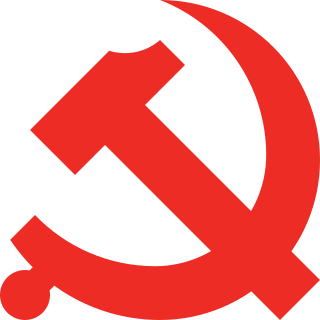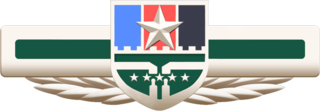
The People's Liberation Army (PLA) is the military of the Chinese Communist Party (CCP) and the People's Republic of China (PRC). It consists of four services—Ground Force, Navy, Air Force, and Rocket Force—and four arms—Aerospace Force, Cyberspace Force, Information Support Force, and Joint Logistics Support Force. It is led by the Central Military Commission (CMC) with its chairman as commander-in-chief.

The Central Military Commission (CMC) is the highest military leadership body of the Chinese Communist Party (CCP) and the People's Republic of China (PRC), which heads the People's Liberation Army (PLA), the People's Armed Police (PAP), and the Militia of China.

The People's Liberation Army Air Force, also referred to as the Chinese Air Force (中国空军) or the People's Air Force (人民空军), is an aerial service branch of the People's Liberation Army. The Air Force is composed of five sub-branches: aviation, ground-based air defense, radar, Airborne Corps, and other support elements.
The history of the People's Liberation Army began in 1927 with the start of the Chinese Civil War and spans to the present, having developed from a peasant guerrilla force into the largest armed force in the world.

Chi Haotian, also spelled as Chih Hao-tien, is a retired general of the Chinese People's Liberation Army. He served as Minister of National Defense from 1993 to 2003.

A theater command is a multi-service formation of China's People's Liberation Army subordinated to the Central Military Commission. Theater commands are broadly responsible for strategy, plans, tactics, and policy specific to their assigned area of responsibility. In wartime, they will likely have full control of subordinate units; in peacetime, units also report to their service headquarters. The services retain administrative and "constructive" control. There are 5 theater commands: Eastern, Southern, Western, Northern, and Central theater commands, organized by a geographical basis.

The chairman of the Central Military Commission is the head of the Central Military Commission (CMC) and the commander-in-chief of the People's Liberation Army (PLA), the People's Armed Police (PAP) and the Militia of China. The officeholder is additionally vested with the command authority over China's nuclear arsenals.
The national security of China is the coordination of a variety of organizations, including law enforcement, military, paramilitary, governmental, and intelligence agencies that aim to ensure China's national security. China considers three factors in its national security: national sovereignty, security, and development interests.

Zhang Youxia is a Chinese general in the People's Liberation Army (PLA) and currently the first-ranked vice chairman of the Central Military Commission (CMC).

The People's Liberation Army Strategic Support Force was a service branch of the People's Liberation Army that existed from December 2015 to April 2024.

The Joint Staff Department of the Central Military Commission (JSDCMC) is the command organ and the headquarters for the People's Liberation Army (PLA), superseding the former PLA General Staff Department (GSD). It was established on 11 January 2016, under the military reforms of Central Military Commission (CMC) chairman Xi Jinping.

The Political Work Department of the Central Military Commission is the chief political organ under the Central Military Commission (CMC). It was created in January 2016 following the military reforms under CMC chairman Xi Jinping. Its predecessor was the General Political Department of the People's Liberation Army.

The National Defense Mobilization Department of the Central Military Commission is a chief organ under the Central Military Commission at the deputy theater grade command level. Like the CMC, it is a "one institution, two names" entity, that combines both party and state functions.

The General Agency for Offices Administration of the Central Military Commission is a first-level functional agency under the Central Military Commission of the People's Republic of China. It was founded on January 11, 2016, under Xi Jinping's military reforms.

The Eastern Theater Command is one of the five theater commands of the People's Liberation Army (PLA), founded 1 February 2016. It replaced the Nanjing Military Region. The command is headquartered in Nanjing.

The Militia or Militia of China is the militia part of the armed forces of China, the other two parts being the People's Liberation Army (PLA) and the People's Armed Police (PAP). The Militia is under the leadership of the Chinese Communist Party (CCP) and serves as an auxiliary and reserve force for the PLA. It is one of the largest militias in the world.
He Weidong is a general (shangjiang) of the People's Liberation Army (PLA) who is currently the second-ranked vice chairman of the Central Military Commission and member of the 20th Politburo of the Chinese Communist Party.
A military unit cover designator is a unique five-digit number used by the People's Liberation Army of the People's Republic of China to externally identify military units. MUCDs are used externally to protect the identity of units, while a true unit designator is used internally as they plainly identify the unit and its function.

The People's Liberation Army Joint Logistics Support Force is the rear echelon and logistics arm of the People's Liberation Army. It was established on 13 September 2016 and was recognized as an arm of the People's Liberation Army on 19 April 2024, with a Deputy Theater grade.

The Joint Operations Command Center of the Central Military Commission (JOCC). is the main command and control of the combined forces of the People's Liberation Army. It is a Theater Command Grade unit under the direct control of the Central Military Commission. Its main headquarter and operations command room is located in an underground location in the Haidian District of Beijing












